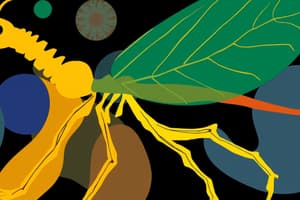Podcast
Questions and Answers
What are the different levels of the taxonomic classification system?
What are the different levels of the taxonomic classification system?
- Genus, Phylum, Kingdom, Family, Order
- Species, Order, Family, Class, Kingdom, Domain
- Order, Class, Kingdom, Species, Domain
- Domain, Kingdom, Phylum, Class, Order, Family, Genus, Species (correct)
What is a basal taxon?
What is a basal taxon?
A branch on a phylogenetic tree that has not diverged significantly from the root ancestor.
Define binomial nomenclature.
Define binomial nomenclature.
A system of two-part scientific names for an organism, which includes genus and species names.
What is the class in the taxonomic classification system?
What is the class in the taxonomic classification system?
What is the family in the taxonomic classification system?
What is the family in the taxonomic classification system?
What is the genus in the taxonomic classification system?
What is the genus in the taxonomic classification system?
What is the kingdom in the taxonomic classification system?
What is the kingdom in the taxonomic classification system?
What is the order in the taxonomic classification system?
What is the order in the taxonomic classification system?
What is a phylogenetic tree?
What is a phylogenetic tree?
What does phylogeny refer to?
What does phylogeny refer to?
What is the phylum in the taxonomic classification system?
What is the phylum in the taxonomic classification system?
What is a polytomy on a phylogenetic tree?
What is a polytomy on a phylogenetic tree?
What does rooted mean in a phylogenetic tree?
What does rooted mean in a phylogenetic tree?
What are sister taxa?
What are sister taxa?
What is systematics?
What is systematics?
What is a taxon?
What is a taxon?
What is taxonomy?
What is taxonomy?
What is an analogy in biology?
What is an analogy in biology?
What is cladistics?
What is cladistics?
What does maximum parsimony refer to?
What does maximum parsimony refer to?
What is molecular systematics?
What is molecular systematics?
What is a monophyletic group?
What is a monophyletic group?
What is a shared ancestral character?
What is a shared ancestral character?
What is a shared derived character?
What is a shared derived character?
Flashcards are hidden until you start studying
Study Notes
Taxonomic Classification
- The hierarchical system includes domain, kingdom, phylum, class, order, family, genus, species.
- Each level reflects a rank of organisms from broad to specific.
Phylogenetic Concepts
- Basal Taxon: Remains close to the ancestral lineage on a phylogenetic tree, with minimal divergence.
- Phylogenetic Tree: Illustrates evolutionary relationships among species or groups.
- Phylogeny: Represents the evolutionary history and connections of an organism or group.
Taxonomic Divisions
- Kingdom: A primary division within a domain.
- Phylum: A subdivision within a kingdom.
- Class: A category within a phylum.
- Order: A division of a class.
- Family: A category within an order.
- Genus: Division of family, represents the first part of a binomial name.
Taxa and Classification
- Taxon: Refers to a single level in the taxonomic hierarchy.
- Monophyletic Group (Clade): Groups of organisms that share a common ancestor.
- Sister Taxa: Two lineages originating from the same branching point.
Analytical Approaches
- Systematics: Focuses on organizing and classifying organisms through evolutionary relationships.
- Taxonomy: The broader science of classifying organisms.
- Molecular Systematics: Utilizes molecular data to establish phylogenetic relationships.
Distinguishing Characters
- Analogy (Homoplasy): Traits that appear similar in different species due to convergent evolution, not shared ancestry.
- Shared Ancestral Character: Traits shared by all species in a phylogenetic tree.
- Shared Derived Character: Traits unique to a specific clade.
Phylogenetic Analysis Techniques
- Cladistics: Organizes organisms based on homologous traits to depict phylogenies.
- Maximum Parsimony: Method that seeks the simplest explanation with the fewest evolutionary steps in tree construction.
- Polytomy: A branch point on a phylogenetic tree with more than two descendant groups.
Key Terms and Definitions
- Rooted: Represents a phylogenetic tree with a single ancestral lineage connected to all organisms depicted.
- Branch Point: A divergence point where ancestor species split into different lineages.
Studying That Suits You
Use AI to generate personalized quizzes and flashcards to suit your learning preferences.




